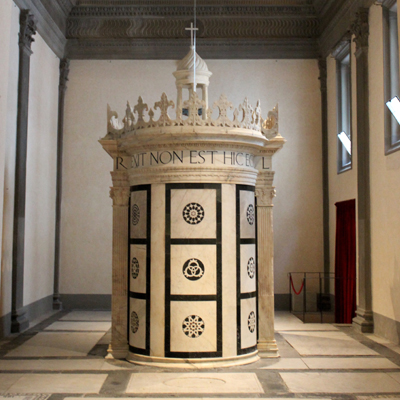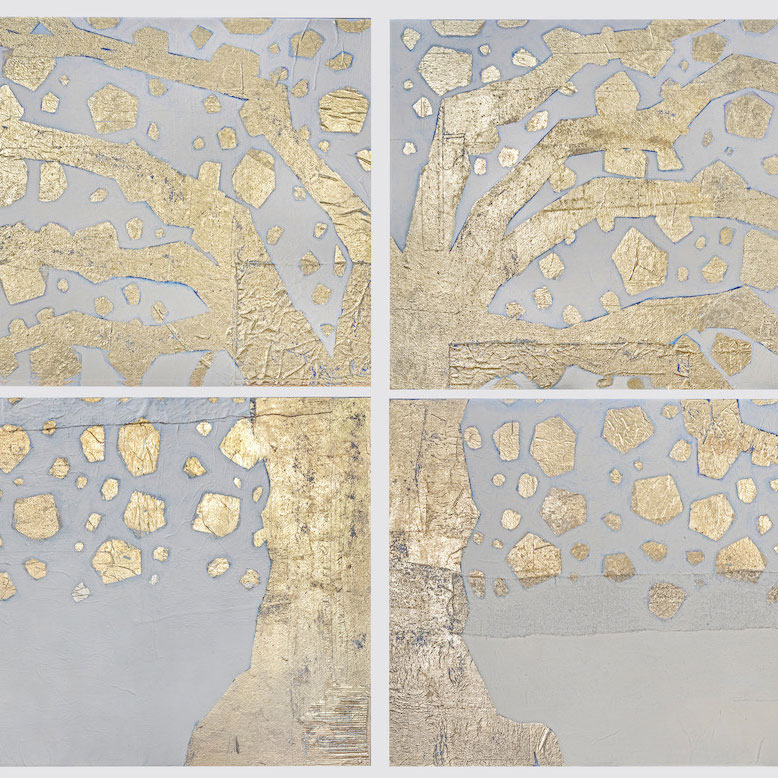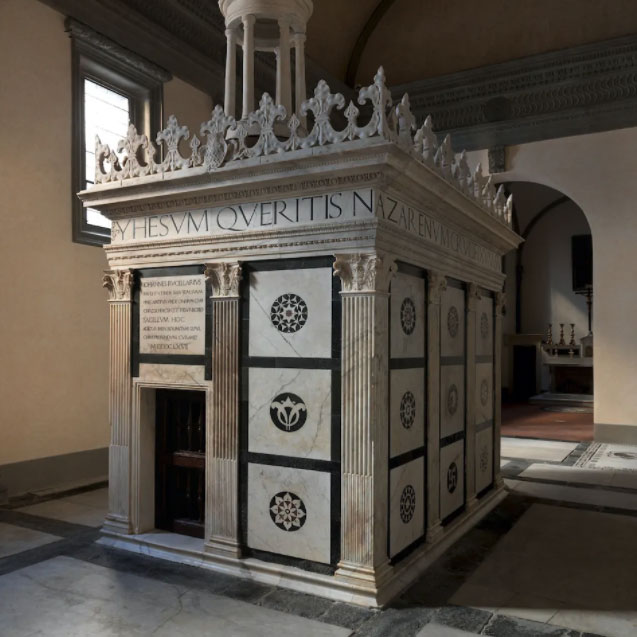Prenotazioni aperte
Per partecipare al convegno è richiesta la prenotazione
Rinascenza come Resurrezione
Studiatissimo dal punto di vista architettonico, il Sepolcro albertiano ha evidente interesse antropologico, teologico e devozionale, ancora da approfondire. Come altre ricreazioni di luoghi gerosolimitani, esso rientra nel processo di topo-mimesi sacra allora diffuso, che nel primo XVI secolo avrebbe portato ai sacri monti di San Vivaldo, in Toscana, e di Varallo in Piemonte. Nell’enfasi sul mistero della Pasqua – l’iscrizione nel cornicione riporta le parole dell’angelo alle donne presso la tomba di Cristo, “Voi cercate Gesù Nazareno, il crocifisso. E’ risorto, non è qui. Ecco il luogo dove l’avevano posto” (Mc 16, 6) -, il Sepolcro si offre poi come icona di fede nella risurrezione corporea del Salvatore. E, associata a un’effettiva sepoltura, mette a fuoco l’identificazione dei battezzati col Risorto sottolineata da San Paolo quando disse: “Se siamo morti con Cristo, crediamo anche che vivremo con lui” (Rm 6, 8). Non a caso l’interno del Sepolcro è decorato di affreschi raffiguranti Cristo morto sorretto da angeli e la Risurrezione, di mano di Giovanni da Piamonte, un allievo di Piero della Francesca.
In realtà l’architettura classicheggiante del Sepolcro e il suo significato cristiano sono connessi, perché all’idea umanista del ‘monumento perenne’, ispirata dal vanto di Orazio, Exegi monumentum aere perennius (Odi, III, 30, 1) la tradizione cristiana associava la memoria della tomba di Cristo, denominata appunto ‘monumentum’ nella Vulgata e nell’antifona pasquale: Sepulto Domino, signatum est monumentum, “Sepolto il Signore, fu sigillato il monumento”. La struttura albertiana, ‘monumentale’ nonostante le dimensioni contenute, infatti compenetra di senso mistico l’ascrizione di gloria mondana, offrendosi come ‘monumento’ cristiano per antonomasia, suprema espressione della dignità del credente defunto.
In questo senso il Sepolcro di San Pancrazio va letto come punto culminante della coeva serie di sacelli classicheggianti in chiese fiorentine, dalla Sagrestia brunelleschiana di San Lorenzo e dai cibori michelozziani all’Annunziata, San Miniato e Santa Maria a Impruneta, alle sepolture degli Strozzi a Santa Trinita alla Cappella del Cardinale di Portogallo in San Miniato. Nel proposito di evocare il Sepolcro di Cristo ubicato sotto la cupola dell’Anastasis gerosolimitana, la struttura albertiana getta luce infine sul coevo interesse fiorentino per edifici a pianta centrale e a cupola – la Sagrestia Vecchia e Santa Maria degli Angeli -, nonché per grandi cupole realizzate per preesistenti chiese basilicali come Santa Maria del Fiore e la Santissima Annunziata.
Per stimolare riflessione e dibattito su questi argomenti, l’Arcidiocesi di Firenze insieme ad altre istituzioni cittadine intende organizzare nel periodo pasquale del 2020 un convegno scientifico e una mostra d’arte contemporanea sul Sepolcro albertiano. Il Museo Marino Marini nell’ex-chiesa di San Pancrazio, dove si trova il Sacello Rucellai contenente il Sepolcro, ha indicato la sua disponibilità a ospitare questi eventi, e la statunitense Fieldstead Company Foundation ha generosamente offerto di sostenerne i costi di realizzazione e pubblicazione.
Renaissance as Resurrection
Extensively studied for its architecture, the San Pancrazio Sepulcher has obvious anthropological, theological and devotional interest, still to be explored. Like other recreations of Jerusalem sites, it belongs to the then widespread process of sacred topo-mimesis which in the early 16th century would create ‘Sacred Mountains’ at San Vivaldo, in Tuscany, and at Varallo in Piedmont. What is more, in its emphasis on the Easter mystery – the inscription on the cornice bears the angel’s words to the women at Christ’s tomb, “You are looking for Jesus of Nazareth, who was crucified. He is risen, he is not here. Behold the place where they had put him” (Mk 16, 6) -, the Sepulcher offers itself as an icon of faith in the Savior’s corporeal resurrection. And with its destination as an effective burial place, it illustrates the Christian’s identification with the Risen Christ underlined by St. Paul, who said: “If we have died with Christ, we believe that we will also live with him” (Rm 6, 8). It is, indeed, no accident that the Sepulcher’s interior has frescoes depicting the Dead Christ Supported by Angels and the Resurrection, by Giovanni da Piamonte, a pupil of Piero della Francesca.
In reality the Sepulcher’s classicizing architecture and its Christian meaning are linked, since to the humanist idea of a ‘perennial monument’, inspired by Horace’s boast Exegi monumentum aere perennius (Odes, III, 30, 1), Church tradition associated the memory of Christ’s tomb, which in the Vulgate is in fact called ‘monumentum’, as also in the Easter antiphon: Sepulto Domino, signatum est monumentum, “When the Lord was buried, the monument was sealed”. Alberti’s structure, “monumental” despite its limited size, thus invests the ascription of worldly glory with mystical significance, offering itself as the Christian ‘monument’ par excellence, supreme expression of the deceased believer’s dignity.
In this sense the San Pancrazio Sepulcher can be read as culminating the series of classicizing aedicules erected in Florentine churches at that time by Michelozzo – at the Annunziata, San Miniato and Santa Maria at Impruneta -, as well as of the resurrection theme in Florentine funerary architecture and art from the Bardi di Vernio tombs in Santa Croce to the Medici ones in Brunelleschi’s sacristy in San Lorenzo, and from the Strozzi sepultures in Santa Trinita to the Chapel of the Cardinal of Portugal in San Miniato. With its proposed evocation of Christ’s Sepulcher placed beneath the dome of the Anastasis in Jerusalem. Alberti’s structure also sheds light on the contemporary Florentine effort to build centrally planned ecclesiastical structures with domes – the Old Sacristy at San Lorenzo and the ‘rotonda’ at Santa Maria degli Angeli -, and on the immense domes added to basilican churches like Santa Maria del Fiore and Santissima Annunziata.
In order to stimulate reflection and discussion on these questions, the Archdiocese of Florence together with other Florentine institutions plans to organize, in the Easter period of 2020, a scholarly symposium and an exhibit of contemporary art on the subject of Alberti’s Holy Sepulcher. The Museo Marino Marini in the ex-church of San Pancrazio, where the Rucellai chapel with the Holy Sepulcher are located, has indicated its willingness to accommodate these events, and the U.S.-based Fieldstead Company Foundation has generously offered to cover the costs of the symposium and following publication.
Rinascenza come Resurrezione
Il Santo Sepolcro di Leon Batista Alberti nella Firenze del Quattrocento
Renaissance as Resurrection
Alberti’s Holy Sepulchre in 15th-century Florence



